What is stuff made of? This is a question that was asked by many many great philosophers and scientists. Let me clarify: the question isn't: what is this wooden chair made of? (Wood, duh!). The question is: are there fundamental building blocks of the Universe? Today, thanks to Rutherford's scattering experiment, we know that stuff is made of atoms, or particles.
(If you're interested about this experiment, you may read more about it at https://steemit.com/cn/@john811/great-experiments-1-rutherford-scattering :D )
It is actually amazing how the world has so many complex objects and yet fundamentally they are all just a bunch of particles, all of which governed by the same laws of Physics. Physicists are really a bunch of particles trying to understand themselves! Atoms and their constituents are not all there is in the Universe, though, waves can also carry energy but they need not contain any particles (at least before we think about wave-particle duality). Waves are pretty!
物質是由什麼構成的呢?很多古代的哲學家及科學家都提出過這道問題。今天,我們知道物質是由原子,或粒子,組成的。我在之前的一篇文章:"偉大的實驗(一): 拉塞福散射" 解釋過拉塞福如何發現原子的構造。如果你還沒有看過那篇文章而有興趣,歡迎去看一下! https://steemit.com/cn/@john811/great-experiments-1-rutherford-scattering
我們的宇宙是何等的複雜,何等的浩翰。然而,這宇宙內所有的一切都由相同的原材料,也就是原子,構成。這些粒子,無論是在我們的身體裏,抑或是在遠方的星體中,都遵守着一模一樣的物理定論,但卻能構成截然不同的物體,可謂非常的神奇。物理學家其實就是一堆粒子,努力地想了解自己!可是這宇宙還有一些奇怪的東西是不由粒子組成的,那就是波。波是很漂亮的 :)
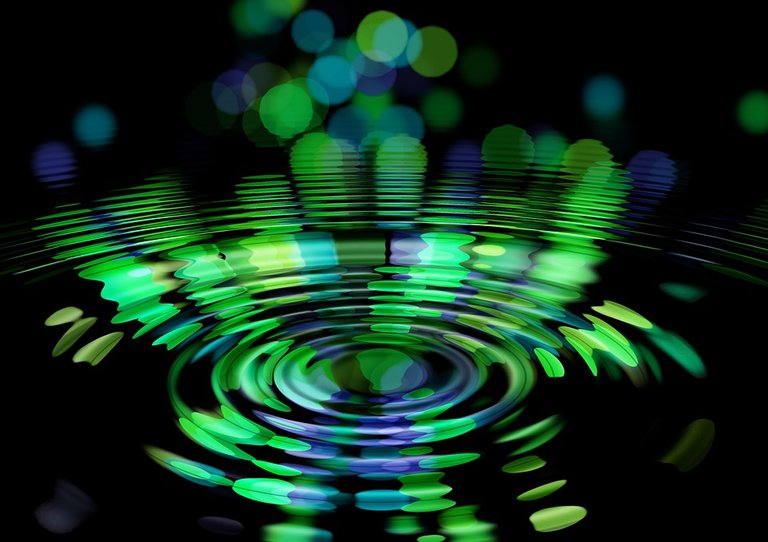
Before we talk about the main topic, Wave-Particle Duality, which, as the name suggests, implies an object can be both a wave and a particle at the same time, let's make sure we understand what waves and particles are and why it is amazing that things can have wave and particle characters both at the same time.
Atoms were long thought to be particles. We can think of them as tiny tiny balls, so tiny that for most purposes we can think of them as points. The size of an atom is around 0.1 nanometre, or 0.0000000001 metres. We are all familiar with how particles behave: if we throw a ball at a solid wall, it will bounce back. If we throw a ball through a big enough gap on the wall, it will pass straight through as though the wall is not there whatsoever.
Waves, on the other hand, have very different behaviours. A very characteristic behaviour of waves is that they diffract when they pass through a gap. Diffraction is when a plane wave passes through a gap and comes out circular. This is very different to particle behaviour: as we just mentioned, a particle passing through a gap will just pass through the gap! It will not diffract or do other funny things. Let's look at some pretty pictures of wave phenomena. An example of a wave is water waves. We can generate them by dropping something into a pond of water:
在我們開始討論這篇文章的主題,波粒二象性,之前,不如大家先想一下什麼是一個波,什麼是一個粒吧。先說粒。原子就是個粒子。原子的大小大概是十億分之一米,所以就是非常非常的小,小的像一粒,一個點一樣。那粒子有什麼特性的呢?基本上就是有着一個球體的特性:如果我們把一個足球往牆壁踢,它就會彈回來。如果牆上有個大洞,它就會直接穿過洞,完全不知道有牆壁的存在。
波卻是截然不同的。比如説,波有一個非常奇怪的特性:如果一個波遇上一個有洞的牆壁,它會進行繞射。正是因為波懂繞射,聲音(聲音是個波)可以像會拐彎一樣,繞過幾道牆直達我們的耳朵。
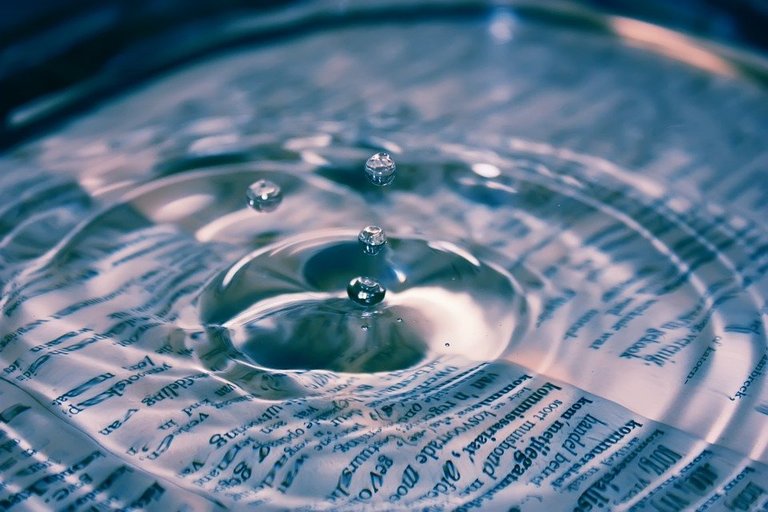
If a wave passes through some gap, it diffracts.
繞射基本上就是當波經過一個洞的時候,它會平平的進去,圓圓的出來,然後就可以達到直線行走不能達到的地方了。
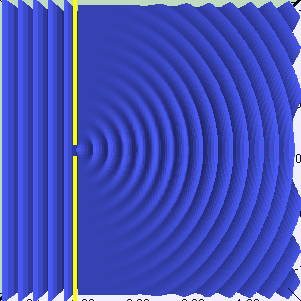

Another everyday example of a wave is visible light; more specifically, visible light is an electromagnetic wave that propagates through empty space at the speed of light at around 300,000,000 metres per second. Other examples of electromagnetic waves include microwaves, UV and X-rays. Electromagnetic waves exhibit wave-like behaviours such as diffraction. A particularly interesting phenomenon takes place when a wave is passed through a double slit. A double slit looks something like this:
另一種我們日常生活中充斥着的波就是光。光其實是電磁波的一種。電磁波是一種以光速,也就是每秒大約三億米,穿透真空的波。其它種類的電磁波包括:微波、紫外線、X光等等。由於光是一個波,它也有着繞射的特性。我們可以利用一套名為雙縫實驗的實驗來看清楚光的繞射。在雙縫實驗中,我們把光照射在一個雙縫上。雙縫是長這個樣子的:
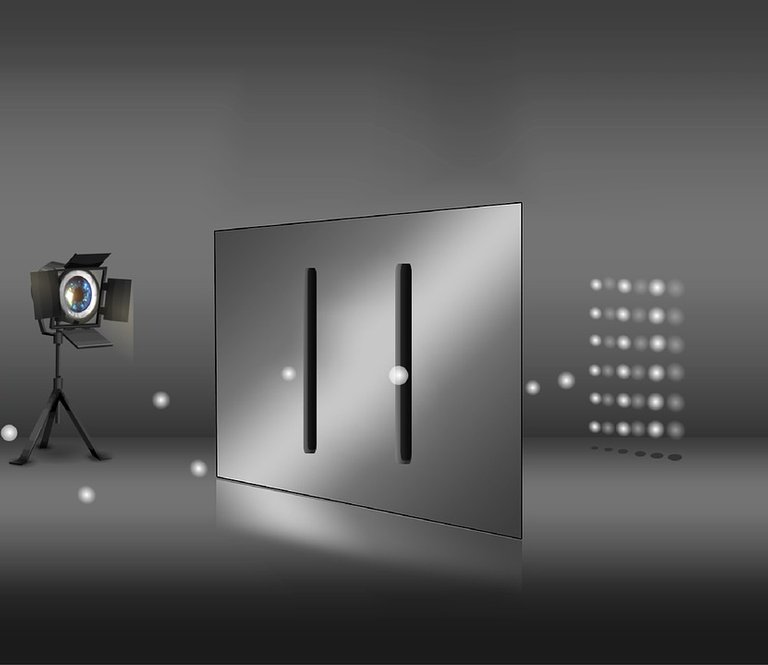
Waves passing through one gap interfere with those passing through the other, resulting in an interference pattern as shown in the picture below.
如果我們照射在雙縫上的是一粒粒的粒子,那一顆粒子定必只能穿過兩縫中的其中一縫。如果我們把一大堆粒子扔過雙縫,我們得到的圖樣就會是兩條直線。有別於粒子,波卻是同是能穿過兩縫的。穿過一條縫的波會跟穿過另一條縫的波進行干涉。結果就是一個干涉圖樣,如下圖:
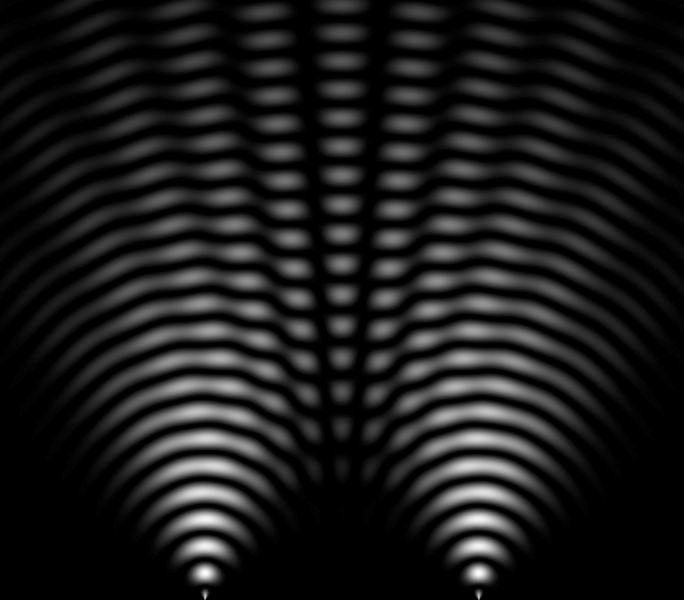
The point is that particles and waves are fundamentally different concepts; for instance, one cannot explain the interference pattern using a particle description. The understanding in the scientific world before the early 20th century was that certain things behave as particles and certain things behave as waves. For example, light was thought to be a wave while an electron was thought to be a particle. In the early 20th century, Einstein proposed that light must consist of particles in order to explain the photoelectric effect.
(I may write another post on the photoelectric effect if people are interested, but the point now is that the photoelectric effect only makes sense if light consists of particles, which we call photons. Einstein was awarded the Nobel Prize in Physics for explaining the photoelectric effect, although many would think that it was for his theory of relativity.)
以上實驗的重點就是,粒和波是有着根本上的分別。比方說,我們把光照射在雙縫上,得到了上圖的干涉圖樣。如果我們把光想成一束束的粒子,是不能解釋這圖樣的形成的。在二十世紀前,科學家知道我們宇宙中的物事可以分作兩類:某些東西是波,某些東西是粒。例如光就是一個波,電子就是一個粒,如此清晰。在二十世紀初期,一個名為光電效應的現象被發現,但有着光作為一個波的前提,光電效應無法被解釋。這時,愛因斯坦走了出來,説光其實是一束束的粒子!因着這發現,愛因斯坦得到了諾貝爾物理學獎,雖然很多人都會以為他得奬的原因是相對論。
Wait a minute. So is light a wave or a particle? In fact, both. The current understanding is that light is a wave and a particle. Under some conditions, it behaves as a wave, and under others, it behaves as a particle. This is wave-particle duality. The obvious question to ask is then, although it took several years before someone asked it: Can particles behave as waves? The answer is yes! Electrons, which we long thought to be particles, can actually diffract! A beautiful illustration of the interference pattern of electrons through a double slit is given below:
等等。那到底光是個波還是個粒?我們不是說光有着作為波特有的特性嗎?我們現在的理解是:光既是個粒,又是個波。這就是波粒二象性。一個明顯的問題就是:那粒又是波嗎?電子是個粒,那它也是個波嗎?對,沒錯。事實上,我們可以在雙縫實驗中看到電子進行繞射及干涉,如下圖:

We can imagine firing electrons at the double slit one by one. Electron diffraction means that as we fire an electron through a double slit, it goes through both gaps at the same time and interferes with itself, producing the final interference pattern. By the way, electron diffraction is illustrated in the double slit picture above. Notice that the screen has multiple lines of electrons, i.e. an interference pattern! If electrons were particles, we would only expect there to be two lines of electrons on the screen.
If you are shocked after reading this, welcome to the amazing quantum world! I was so amazed when I heard about wave-particle duality and this eventually led me to study Physics at uni. There are many other interesting ideas in Quantum Physics that go against our natural intuition. This is unsurprising: after all, the quantum physics happens on scales so small that we do not experience it in everyday situations. However, very precise experiments can be done these days and quantum effects can be very clearly seen.
我們可以想像把電子射向雙縫。電子的繞射代表當一顆電子接近雙縫時,它化身成波,同時穿過兩縫,最後跟自己進行干涉。如果你覺得這太恐怖了,歡迎來到量子力學的世界!當我初初接觸這些概念時,我也是如此的驚訝。最後,我的好奇心讓我踏上了修讀物理的旅途。量子力學中還有許多令人震驚,跟人類直覺完全相反的現像。這本身其實是合理的:量子的世界非常小:肉眼是絕對看不到那個世界的。因此,我們在日常生活中其實沒有跟量子世界打過交道。現在,科技讓我們可以非常精準地進行量子實驗,物理學家可以清楚地看到各種量子理論中的預測。
If you've read this far, thank you very much! :D Wave-particle duality is a central concept in Quantum Physics that encapsulates many ideas in Quantum Physics. This article has only covered a subset of the ideas. If you have enjoyed reading, please leave a comment to encourage :) Other comments and questions are most welcome! :D
我在這篇文章裏只是很大概地介紹了一下量子力學中的波粒二象性。波粒二象性裏面包含着量子力學中最重要的幾個概念,是在一篇短文章裏無法全數道盡的。有機會的話,希望能跟大家分享多一點這個神奇的國度。希望讀者們繼續支持!
好厲害吖!!!! 最近都在看電子繞射的解釋,你的解釋非常清晰
對於電子能在縫前化身成波這樣東西真的很抽象,但現實的結果又叫人讚嘆!
謝謝。我也只能說我們身處的這個宇宙太神奇了。
簡潔的理論描述,如有更深入的實際應用或對應近代所謂的dark energy/dark matter的宇宙現狀推論,可能更引人入勝。
多謝!Dark Energy 和 Dark Matter 可能將是另外數篇文章的主題 :)
Very nice explanations. Really! (And believe me, I have already seen a bunch on this topic.) What are you working on exactly, as a half-physicist?
[I don't like self-advertising myself, but you may be interested by a quantum mechanics series I started months ago (and that progresses very very slowly) and where I have already addressed the photoelectric effect, for instance (but I haven't touched the particle-wave duality so far).]
Hi lemouth. Thanks for your kind words! I have recently graduated from a Maths/Physics degree, currently taking a break. So delighted to meet someone who writes about Physics! I shall check out your quantum mechanics series. I am still new and have started several 'series', although at present each of them only has one post LOL
Glad to hear that you have written an article on the photoelectric effect; I encourage those who have just read the post above to read it!
很牛。虽然我对物理的认识还停留在 牛顿第二定理,动能守恒,其它的全忘记了。
牛頓可説是物理學的始祖。他的定理還是非常牛的哈哈。
嗯,所以叫 “牛” 顿 哈。
我居然沒有發現這事哈哈
Information, the fundamental thing that all else is made from is information. Check out Physicist Thomas Campbell's work in this field.
I've always thought the uncomprehensible-ness of the wave-particle duality comes from the fact that we have defined a "particle" and a "wave" from what we have experienced in our immediate reality - we can see how waves work when we interact with water, and we generally believe that a particle acts in the way of a ball - a tennis ball bouncing around a room for example. Then at no point have we seen water act like a ball or vice versa - these bahaviours seem to be incompatible with each other. We have then applied these concepts when trying to understand the quantum world in some sort of top down metaphor, which ultimatly leads to an explanation that goes against our natural intuition. If we get rid of these preconceived ideas that we enforce onto quantum behaviour and take a "bottom up" approach, I think the concept is easier to understand. That is to say that an electron behaves in a certain way - in some circumstances it creates an interference pattern and in some circumstances it does not, these are its properties . These are the facts and our starting point in our understanding. Our similies and metaphors for understanding our universe can be limiting in some cases and we need to accept new fundamental concepts in order to grasp the phenomena what we observe. This is how I've always wrapped my head around this. Great article and a fascinating subject!
@bramlyapple I think you got this! Indeed Nature does not have to conform to our limited intuitions. We should perhaps think of an electron as sort-of-a localised wave packet that resembles both a wave and a particle, and hence has particle-like as well as wave-like behaviours. Indeed, the de Broglie formula tells us how to relate the momentum of a particle and its wavelength, so a wave description and a particle description are not mutually exclusive at all.
UpVoted and follow . Please follow me back.
wow ,lovely article doc
Thanks lolcat :) Glad you enjoyed it!
good information
写的很清晰,逐字逐句看完的我表示很想了解更多量子力学的世界,期待后续,follow!
謝謝你逐字逐句的看完!如果你覺得哪裡我講的不清晰,請指出!也許將會是另一篇文章的主題! :)
@john811 there is always a huge leap in quantum physics
Indeed Quantum Leap is a thing!
Well that was a mind bender! Well done.
Well done to the amazingly clever scientists that did all the work for us :)
👍👍👍👍
Definitely worth an upvote and a resteem :]
@smartdeveloper You're so kind!
What you send out is what you recieve ;)
Join us on #steemSTEM / Follow our curation trail on Streemian
Thank you for this very interesting article. It has been advertised on our chat channel (and upvoted).
The steemSTEM project is a community-supported project aiming to increase the quality and the visibility of STEM (STEM is the acronym for Science, Technology, Engineering and Mathematics) articles on Steemit.
Thanks so much @steemstem ! I'm quite new to steem. Please could you let me know how in other ways I can participate in steemSTEM activities? Also, what are the criteria for a post to be advertised by you?
Join us in the steemSTEM chat channel, links above~ We are current starting a science fair contest~
Sure. Thanks for letting me know biuiam!
Awesome post!! better cite some source, for photos and contents, steemSTEM would prefer post with reference and source~
Hi biuiam, thanks for the kind reminder! All the images that I used are marked as 'free to use or share' by google. I will make sure that is 100% clear in the future. I will also cite sources when there are specific results that I quote. Glad you liked this post. I hope you will only be more satisfied with the future ones!
Amazing article.
Your post reminds me of my quantum physics class.
Well, I think everything has a dual nature. But it's mostly observable in smallest particles and electromagnetic waves.
Very nice to read it, and images and animations used are just outstanding.
Keep it up bro @john811. :)
Cheers @nitesh9. Glad you enjoyed reading my post! :)
wave particle duality does not exist. Define a wave. A wave is a process of transmitting force over a distance through a medium. A wave does not exist.
A wave is a process not a noun. Check out "Ken L. Wheeler" also check out www.thunderbolts.info
You can think of wave as the process of transmitting energy through a medium, this is perfectly fine. Or, you can think of the wave as a manifestation of the energy being transmitted. These may just be different ways of defining the wave. However, I think the definition I used is more conventional, as for example we normally think of water waves on an ocean as a physical thing, rather than a process. Interesting perspective though and thanks for your bringing this up @brainkerr !
A wave is what you get when projecting a point revolving around a circle on its axis ! At least that the trigonometric definition.
A signal spectrum is modelized as sum of wave with different frequencies ( point moving at different speed around the circle), using fourrier series.
amazing!! following you for more.
Many thanks alejandr0!
按照量子理论,双缝实验如果仅发射一个电子,也是可以测到干涉图案的。是这样吗?很好奇这个图案是什么样子,又是如何测量的?
如果是一個一個電子發射出去,最後會在縫後的屏幕上發現一顆一顆的電子散佈在一條一條的直線上。這一條一條的直線就是干涉圖案。本文第五張圖片就是表達了這個現象 :)
我是说如果一共只发一个电子,那么观测到的是什么?一个点吗?
有一种对波粒二象性的解释是,统计意义上呈现波的特征,单个个体仍然是粒子。但这个似乎已经被证明是错误的了。所以我会有上面的疑问。
只發一個電子,最後就只能見到一顆電子。它會有機會在干涉圖案的其中一條直線上。這代表電子是一個粒子嗎?不。這只是代表了我們在某些情況下會看到電子是一顆粒子。然而當電子穿過雙縫時,它必然是一個波。
谢谢回复,受教了,看来还需要继续学习
Congratulations @john811! You have completed some achievement on Steemit and have been rewarded with new badge(s) :
Click on any badge to view your own Board of Honor on SteemitBoard.
For more information about SteemitBoard, click here
If you no longer want to receive notifications, reply to this comment with the word
STOPgood education
thank you
You're welcome!
Thanks for your thorough post! If I may, I would like to hear what you think of the following:
Important features about the double-slit experiment are: the slit width, and the velocity of the particle (when the particles are larger such as a molecule, they must pass through smaller slits at slower speeds in order to produce an interference pattern).
What that tells us is that: diffraction is gravitational lensing. If the slit is large, the vast majority of the particles will pass through the slit at a distance from the walls of the slit that is too large to be substantially gravitationally lensed by the local gravity when passing through the slit. If the slit is sufficiently small, any slight variation in the flow pattern of the particle from the exact center of the slit will cause a local gravity variation on the particle that will arise in the observed diffraction. This would lead to a wave such as we see. If the particle is high in mass, it must travel slower so as to be exposed to the local gravity for longer so as to go from a particulate result to an interference pattern.
In this way, light is a wave of particles, in the same way as a wave in the ocean is a wave of particles. Other particles can also produce interference patterns when they are small enough in mass and/or travel slow enough to have the actual local gravity of the slit influence the trajectory of the particles.
-Steve
Hi Steve,
Sorry for the late reply. I must say what you said is very interesting, though I think if diffraction is gravitational effects then the observed diffraction pattern will not be vertical lines but a continuum instead.
Dicken
Hi Dicken, thanks for the response!
I agree, that's how it would seem but maybe there is something missing in the way that small particles interact in this way; like within certain ranges of the electromagnetic field of the slit material--within each "ring" of the field--they are gravitationally lensed similarly akin to orbitals. Not to say that that is what is going on, but there could be something missing in a particle interpretation based on gravity that is not immediately obvious. We happen to interpret interference patterns as the result of waves, but that does not preclude them from being the result of particles traveling together as waves on such a small scale level. Even single slits produce interference patterns, after all. Just some thoughts, still contemplating that exact thing myself.
Congratulations @john811! You have completed some achievement on Steemit and have been rewarded with new badge(s) :
Click on any badge to view your own Board of Honor on SteemitBoard.
For more information about SteemitBoard, click here
If you no longer want to receive notifications, reply to this comment with the word
STOPCongratulations @john811! You have completed some achievement on Steemit and have been rewarded with new badge(s) :
Click on any badge to view your own Board of Honor on SteemitBoard.
For more information about SteemitBoard, click here
If you no longer want to receive notifications, reply to this comment with the word
STOPCongratulations @john811! You have received a personal award!
Click on the badge to view your Board of Honor.
Congratulations @john811! You have completed the following achievement on the Steem blockchain and have been rewarded with new badge(s) :
Click on the badge to view your Board of Honor.
If you no longer want to receive notifications, reply to this comment with the word
STOPDo not miss the last post from @steemitboard:
Congratulations @john811! You have completed the following achievement on the Steem blockchain and have been rewarded with new badge(s) :
Click here to view your Board
If you no longer want to receive notifications, reply to this comment with the word
STOPCongratulations @john811! You received a personal award!
You can view your badges on your Steem Board and compare to others on the Steem Ranking
Vote for @Steemitboard as a witness to get one more award and increased upvotes!
Congratulations @john811! You have completed the following achievement on the Hive blockchain and have been rewarded with new badge(s) :
You can view your badges on your board And compare to others on the Ranking
If you no longer want to receive notifications, reply to this comment with the word
STOPDo not miss the last post from @hivebuzz:
Support the HiveBuzz project. Vote for our proposal!